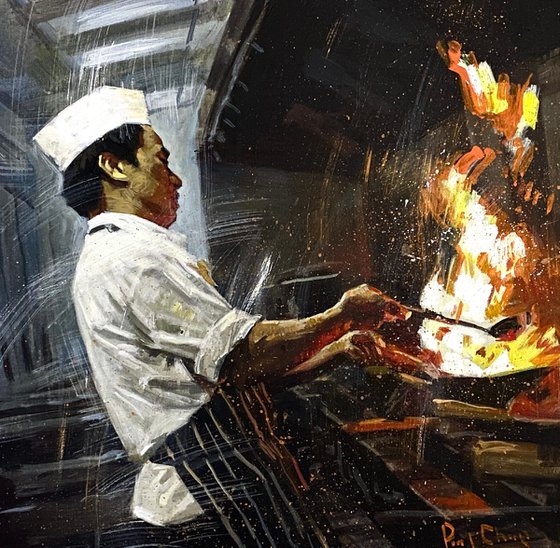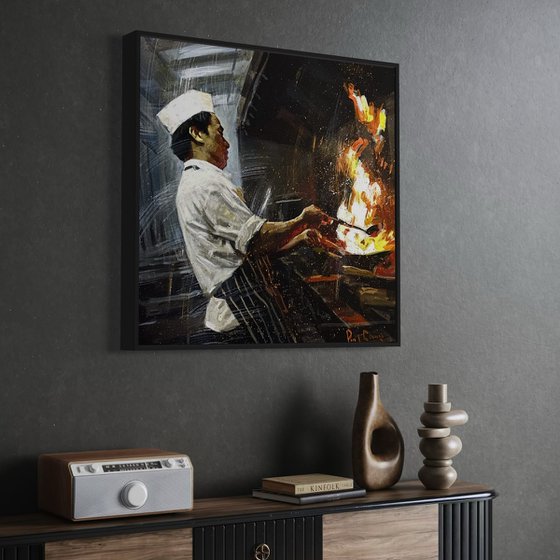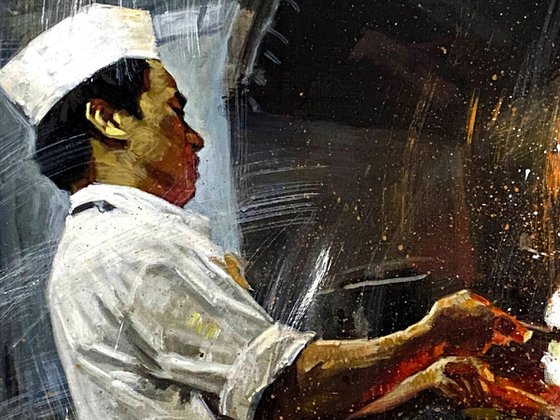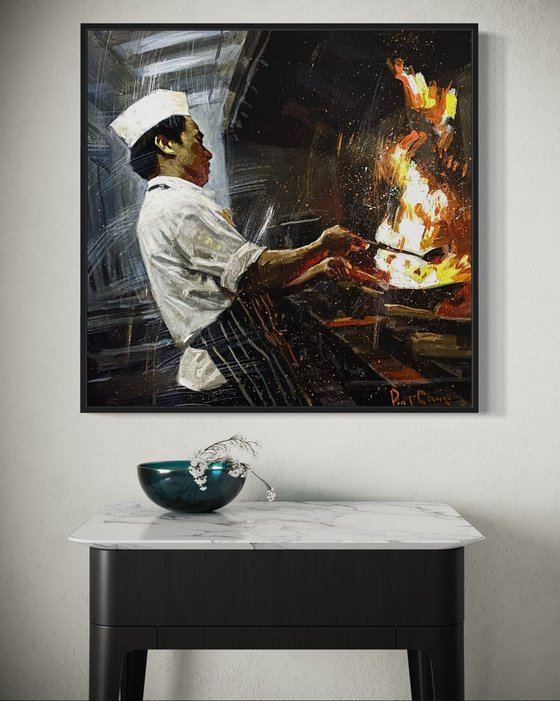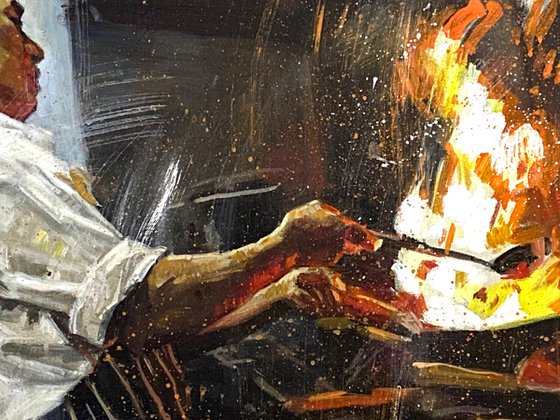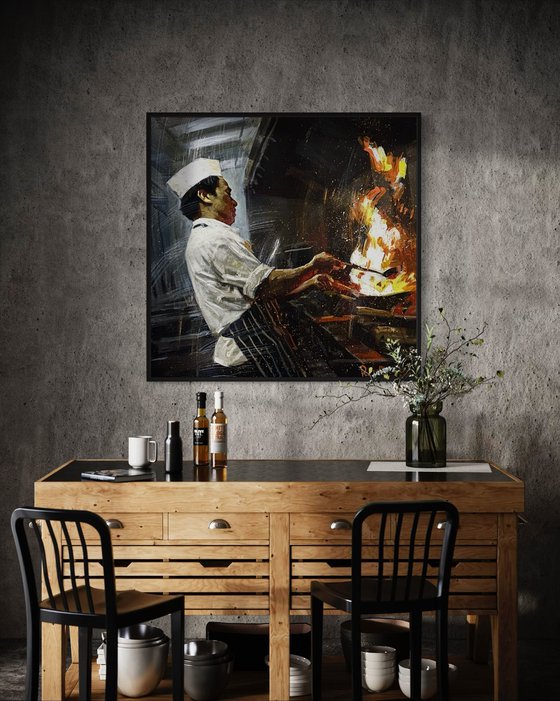- By medium
- By subject
- By budget
- Sales
- Gift cards
- Discover all art
- Artists
- Editors’ picks
- Ideas
Original artwork description:
TThis painting exhibits a strong sense of movement and drama from an artistic perspective. Here is an analysis from several key artistic angles:
1. Composition and Dynamics
• The main subject is the chef, with the flames serving as the visual focal point, enhancing the dramatic effect.
• The composition utilizes diagonal lines (such as the chef’s arms, spatula, and flames), creating a strong sense of movement. This allows the viewer to feel the intense heat and the rhythm of cooking.
2. Use of Color
• The painting primarily employs warm tones (orange, yellow, and red) to depict the heat of the flames, while the dark background contrasts sharply, making the fire stand out even more.
• The artist uses striking color contrasts—bright flames against a dark background—to emphasize the subject and heighten the dramatic impact.
3. Brushstrokes and Texture
• The brushstrokes are bold and expressive, reminiscent of Impressionist or Expressionist techniques, adding emotion and energy to the scene.
• The flames are painted with vigorous strokes, almost as if they are consuming the canvas, while the chef’s form is more defined, creating a sense of depth and structure.
4. Light and Shadow Effects
• The painting employs strong chiaroscuro (light and dark contrast), similar to the chiaroscuro technique, which enhances the three-dimensionality and dramatic intensity.
• The side of the chef’s face is illuminated by the firelight, contrasting with the shadowed areas, emphasizing his concentration and the tension of kitchen work.
5. Emotion and Narrative
• The painting captures a moment of intense focus as the chef works amid flames and heat, conveying the passion and craftsmanship of cooking.
• The flames are not only a source of light but also symbolize energy and vitality, making the scene feel alive and dynamic.
Conclusion
This artwork successfully creates a vivid and intense kitchen scene through bold colors, dynamic composition, strong contrasts of light and shadow, and expressive brushstrokes. It not only showcases the chef’s concentration and skill but also allows the viewer to experience the passion of cooking and the heat of the flames. It is a highly expressive and powerful piece of art.
Materials used:
Acrylic
Tags:
#painting #acrylic #impressionist art #chinese food #chinese chefFlaming Culinary Soul (2025) Acrylic painting
by Paul Cheng
94 Artist Reviews
£597.77
- Acrylic painting on Canvas
- One of a kind artwork
- Size: 60.96 x 60.96 x 2.03cm (unframed)
- Ready to hang
- Signed on the front
- Style: Impressionistic
- Subject: People and portraits
Loading
Original artwork description
TThis painting exhibits a strong sense of movement and drama from an artistic perspective. Here is an analysis from several key artistic angles:
1. Composition and Dynamics
• The main subject is the chef, with the flames serving as the visual focal point, enhancing the dramatic effect.
• The composition utilizes diagonal lines (such as the chef’s arms, spatula, and flames), creating a strong sense of movement. This allows the viewer to feel the intense heat and the rhythm of cooking.
2. Use of Color
• The painting primarily employs warm tones (orange, yellow, and red) to depict the heat of the flames, while the dark background contrasts sharply, making the fire stand out even more.
• The artist uses striking color contrasts—bright flames against a dark background—to emphasize the subject and heighten the dramatic impact.
3. Brushstrokes and Texture
• The brushstrokes are bold and expressive, reminiscent of Impressionist or Expressionist techniques, adding emotion and energy to the scene.
• The flames are painted with vigorous strokes, almost as if they are consuming the canvas, while the chef’s form is more defined, creating a sense of depth and structure.
4. Light and Shadow Effects
• The painting employs strong chiaroscuro (light and dark contrast), similar to the chiaroscuro technique, which enhances the three-dimensionality and dramatic intensity.
• The side of the chef’s face is illuminated by the firelight, contrasting with the shadowed areas, emphasizing his concentration and the tension of kitchen work.
5. Emotion and Narrative
• The painting captures a moment of intense focus as the chef works amid flames and heat, conveying the passion and craftsmanship of cooking.
• The flames are not only a source of light but also symbolize energy and vitality, making the scene feel alive and dynamic.
Conclusion
This artwork successfully creates a vivid and intense kitchen scene through bold colors, dynamic composition, strong contrasts of light and shadow, and expressive brushstrokes. It not only showcases the chef’s concentration and skill but also allows the viewer to experience the passion of cooking and the heat of the flames. It is a highly expressive and powerful piece of art.
Materials used:
Acrylic
Tags:
#painting #acrylic #impressionist art #chinese food #chinese chef14 day money back guaranteeLearn more
